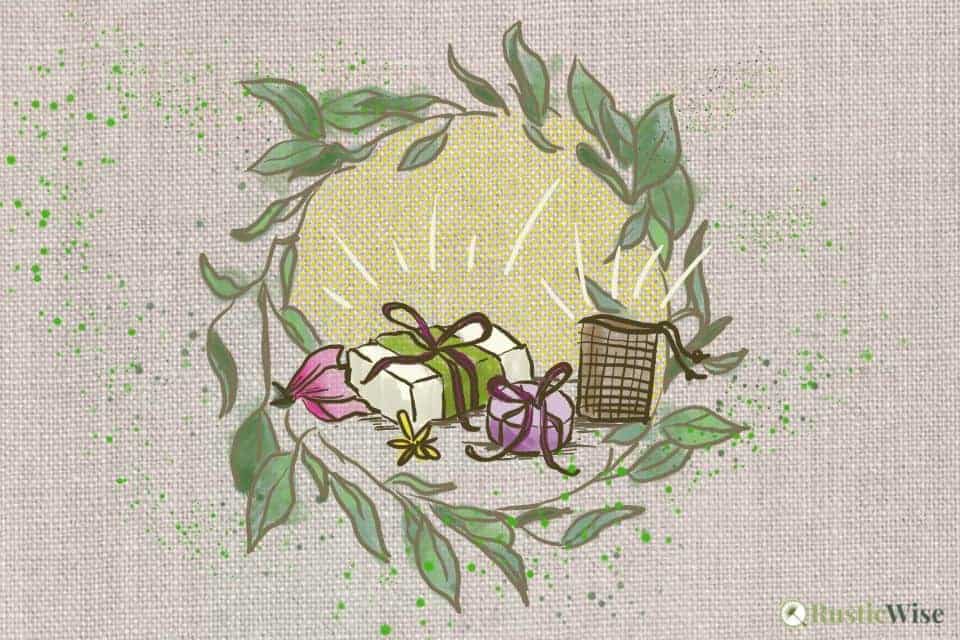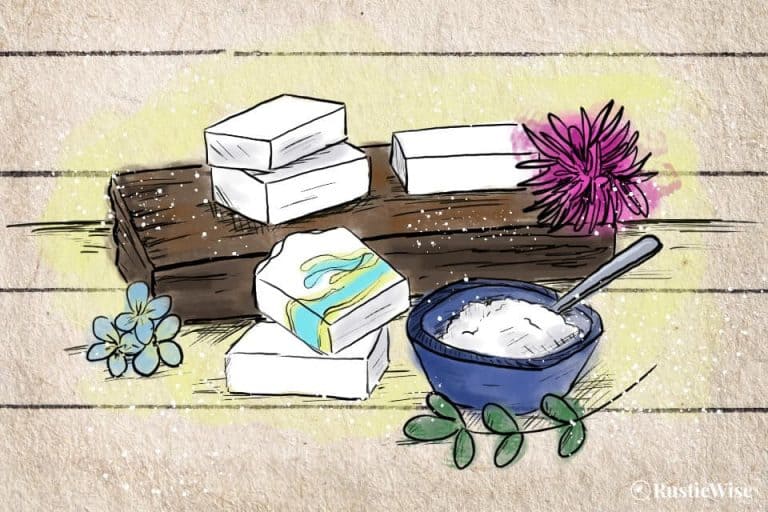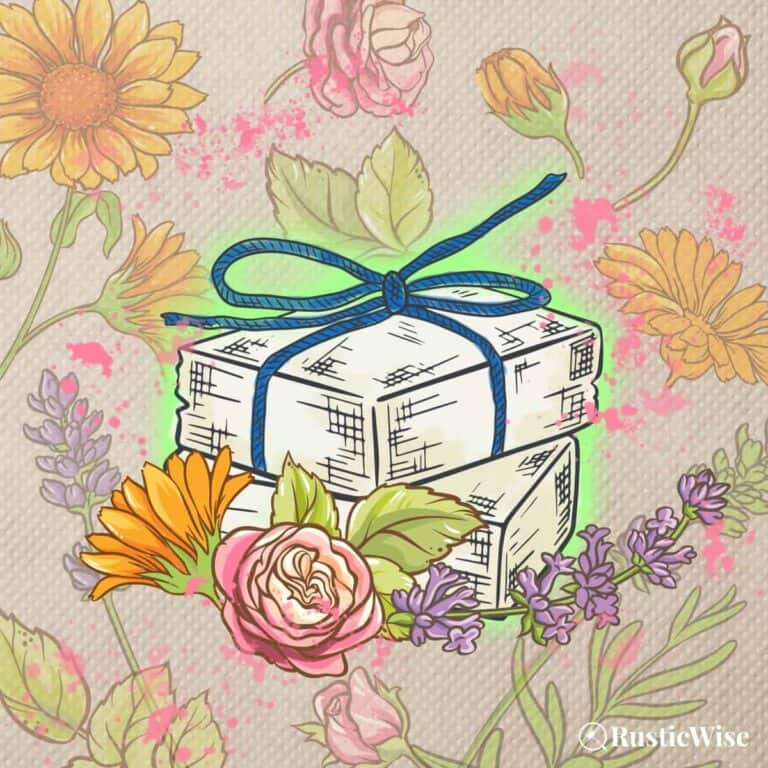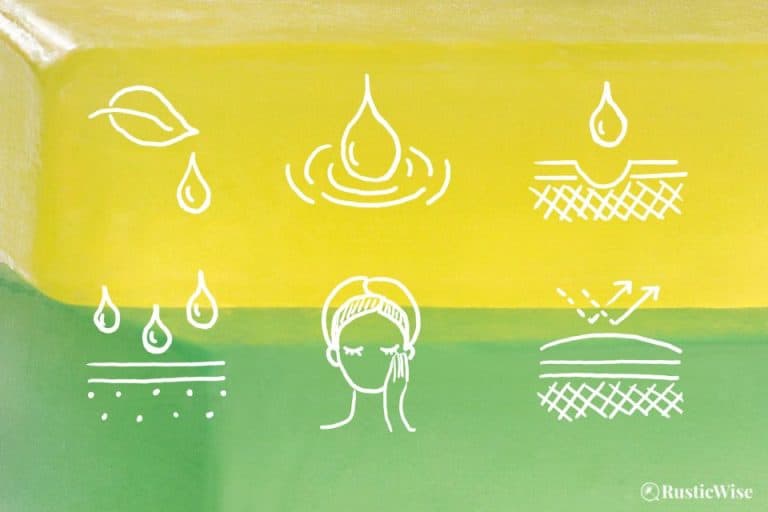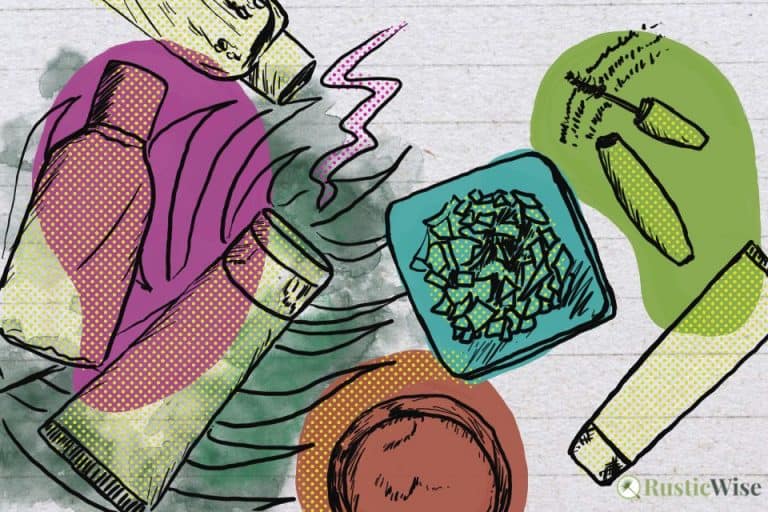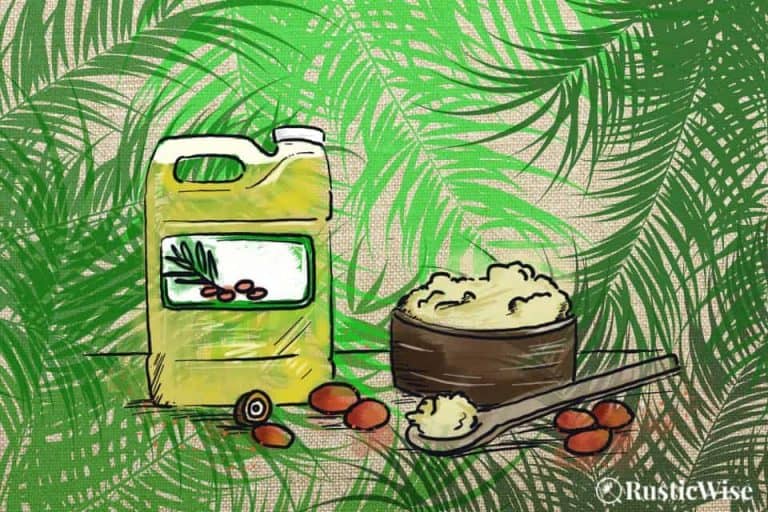14 Creative Eco-Friendly Soap Packaging Ideas That Impress
You’ve spent the time, effort, and money on making homemade soaps and lotion bars. How you package the finished product and present it to the world says a lot about your products and your values.
If minimizing your carbon footprint is important to you, here’s a roundup of 14 eco-friendly soap packaging ideas that feature materials that complement your handmade soaps AND are gentle on the environment. From recycled paper, boxes, bags, and fabrics, there are so many creative soap packaging ideas with an environmentally friendly ethos.
Whether you’re looking for creative ways to wrap bars of soap as gifts, or have a budding soap business, it’s all about the presentation. And if your product packaging is environmentally friendly, then all the more power to you.
This article focuses mainly on soap bars rather than liquid soap. Let’s dive right in!
What exactly does eco-friendly mean?
Everyone has a different idea about what eco-friendly actually means.
I think we can all agree with the standard definition provided by the Cambridge Dictionary, “Eco-friendly products have been designed to do the least possible damage to the environment.”
At a minimum, eco friendly soap packaging shouldn’t cause harm to the earth. The degree to which you choose to extend that definition is entirely up to you.
For example, you may look at products that meet one or more of the following criteria:
- Sustainable materials;
- Uses green energy during production;
- Biodegradable soap packaging;
- Compostable materials; and,
- Recyclable (or made of recycled material).
Soap packaging can have a significant impact on the environment. Not only is the material that it’s made of important, but the design and look of the packaging is also something to think about.
“Eco-friendly products have been designed to do the least possible damage to the environment.”
Cambridge Dictionary
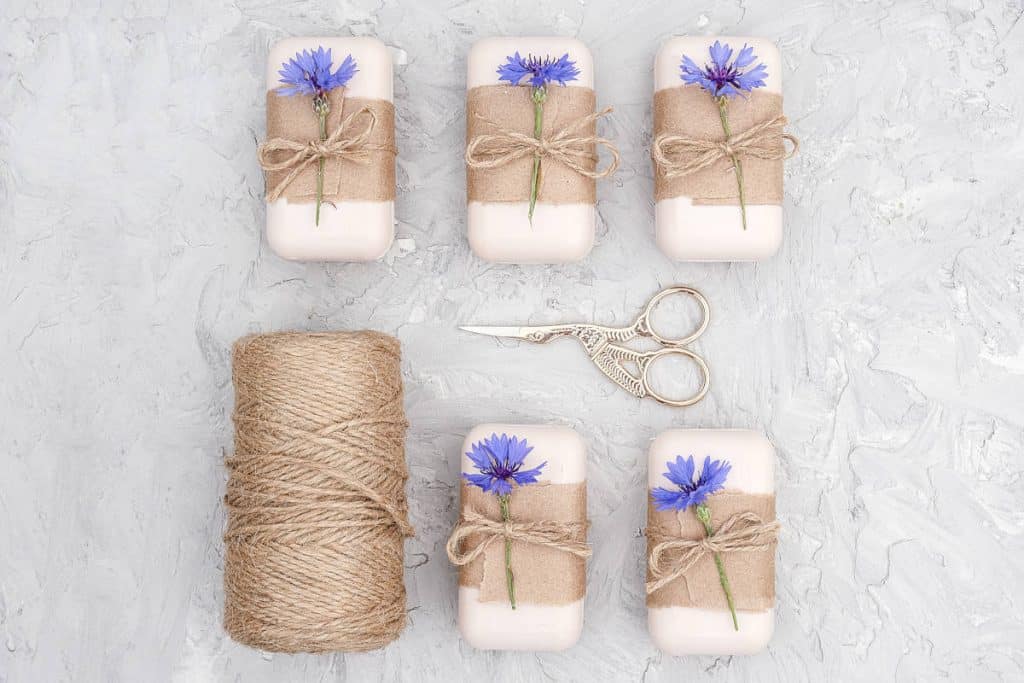
Credit: 123RF.com
Things to consider when choosing eco-friendly soap packaging
As you brainstorm various packaging ideas for soap bars, here are a few considerations to keep in mind.
- Type of soap: Natural soaps made using cold process or hot process methods do better when stored with plenty of air circulation. Melt and pour soaps store better when sealed to prevent glycerin “sweating.”
- Cost: Some eco-friendly packaging materials cost a pretty penny, while others may cost next to nothing (think upcycled containers or materials you already have at home). If you’re planning to sell your soap, you’ll find it’s often best to buy in bulk.
- How you sell your soaps (individually or in bundles): Give some thought whether you’re planning on wrapping individual bars of soap or bundling more than one item together. Paperboard or cardboard boxes work well if you’re grouping multiple bars of soap.
- The look you’re trying to convey: How would you best describe your handmade soap? The packaging material you use says a lot about your products. A few ideas are: rustic, luxurious, natural, or elegant. Chances are, if you’re making natural or organic soaps, eco-friendly or low-waste packaging goes hand-in-hand.
- Packaging design: Ideally, you would find something that checks off all the boxes: a sustainable material that minimizes waste and appeals to your customer or gift recipient.
14 Eco-friendly soap packaging ideas
More than just plain brown paper, the world of environmentally friendly soap products and packaging has come a long way.
If you’re wrapping a bar of soap for friends or family, look at items you already have on hand. You can get creative and find a packaging solution that upcycles fabric or paper into something gift-worthy.
We’ve organized the following creative soap packaging ideas into several categories:
- Papers
- Boxes and containers
- Bags
- Fabrics
- Other ideas
- Strings
Papers
When looking for types of paper products, check for a FSC label or certification. This stands for Forest Stewardship Council® (FSC®) which means wood pulp is sustainably sourced.
1. Kraft paper
If you’re looking for natural soap packaging ideas, look no further than kraft paper.
The OG of sustainable packaging, brown kraft paper is a mainstay for several reasons. It’s affordable, easy to use, and provides a rustic look many people love.
Is kraft paper eco-friendly? Yes, most kraft paper is biodegradable, recyclable, and compostable. It’s made primarily of wood pulp (which gives the paper its distinct brown color). High quality recyclable kraft paper is also sturdy, which makes it practical for wrapping a variety of objects.
2. Parchment paper
If you’re wrapping lotion bars or body bars, parchment paper (aka baking paper) may be a good choice for you. Lotion bars are prone to melting, so they need a protective packaging layer. Parchment paper is grease-proof, so you won’t need to worry about melty or messy lotion bars.
Parchment is also great for regular soap bars, too.
Look for unbleached parchment paper that’s gentler on the environment.
While most parchment papers are biodegradable, they’re often not recyclable if it’s contaminated.
Parchment paper is coated in silicone, so I would question if that’s something you want to throw into the compost pile!
3. Wrapping paper
The world of wrapping paper has thankfully taken a more environmentally conscious turn and you can find many recycled paper options printed with plant-based ink.
Many types of wrapping paper can safely be recycled so long as you remove any tape and ribbons. Anything glittery, or made of foil sadly, is not a “green” soap package material.
4. Tissue paper
Tissue paper will make every bar of soap feel like a gift!
Look for tissue paper made of recycled materials and harvested from sustainably sourced trees. If you’re planning on making custom printed tissue paper with your own logo or unique design, look for inks that are water-based or plant-based (such as soybean) rather than traditional petroleum-based inks.
Many types of tissue paper are recyclable. Those that are made of natural materials and dyes are prime candidates for composting. Avoid tissue papers with glitter, metallic or plastic finishes, or other synthetic add-ins which are not compostable.
Tip: Some colors on tissue papers may “bleed” onto soap. Be careful, especially if your soap bars are white, or light-colored.
5. Plain recycled office paper
Sometimes simple and unpretentious materials work well.
A standard sheet of office paper (8½ x 11 inches) can be great for wrapping individual bars of soap.
Look for products made with post consumer waste (PCW) recycled fibers, and processed chlorine free (PCF).¹
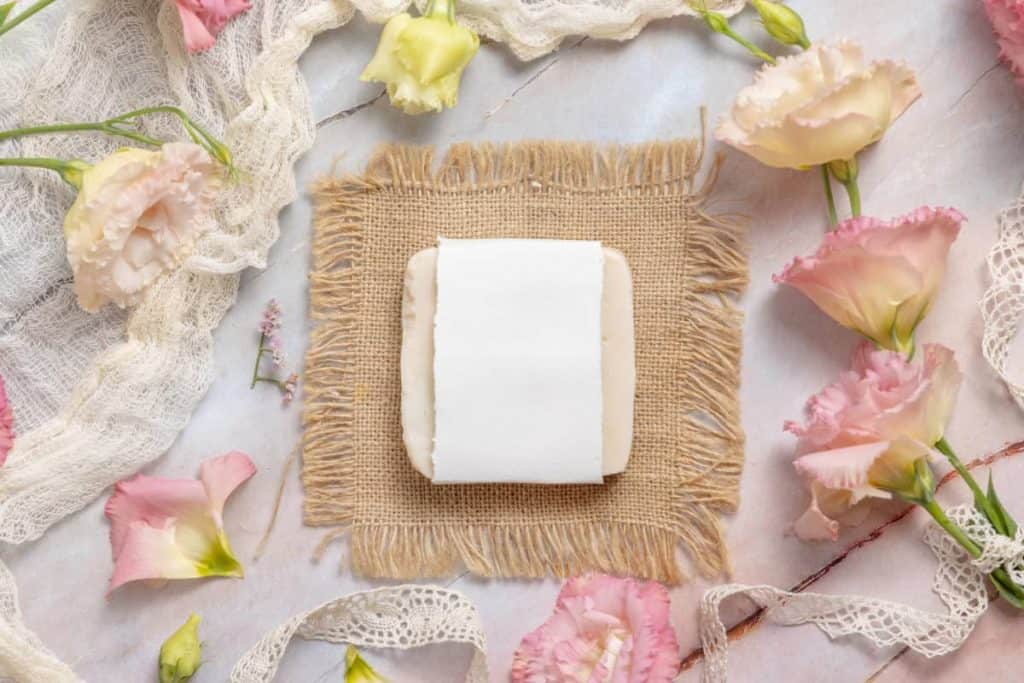
Credit: 123RF.com
Boxes and containers
6. Paperboard or cardboard soap box
Soap boxes come in a variety of sizes great for individual bars, or bundles. Some display boxes also have cutout windows that let you peek (and sniff) the soap.
Look for paper boxes made of recycled contents and that are unbleached.
Most types of unbleached cardboard are recyclable and compostable (so long as they don’t have a plastic or waxy lining).
What about custom soap packaging? If you’re looking for a more personalized touch, you can find many companies that will make a custom soap box with your logo and desired colors.
A pillow box is another great option for individual bars. With foldable end flaps that secure the soap bar in place, you don’t need tape or stickers.
Thinking of bundling your wares? You’re not limited to small boxes to sell your homemade soap. Get creative and you might find a food box, a cake box, or a gift box made of recycled cardboard that fits your needs.
7. Metal tins
Metallized boxes or tins have become synonymous with Lush products, but they are a brilliant choice for gifts, too. (The price of metal tins makes it a bit steep if you’re selling many bars of soap.)
Aluminum or steel tins are reusable and recyclable. They’re also great for packing your soap bars when travelling or camping.
Fabric Bags
What can be easier than slipping a bar of soap into a small fabric pouch? Most fabric bags come with a drawstring, making it easy to slip in and close.
Try to choose fabrics that are natural and sustainable. The great thing about fabric bags is that they provide beautiful packaging that’s easy to reuse.
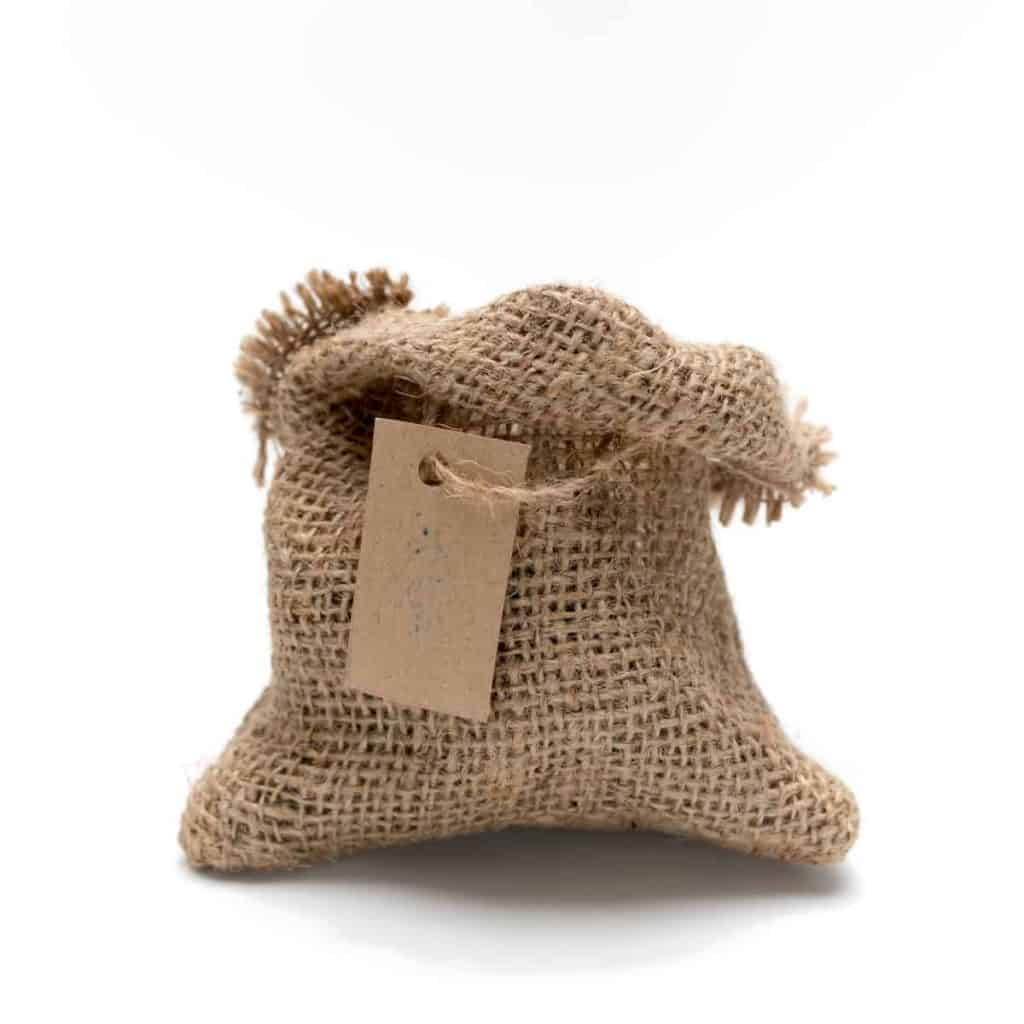
Credit: Yay Images
8. Burlap bags
Burlap is a natural fiber made from hemp, jute, or flax yarn.²
Look for organic burlap produced without the use of pesticides. Burlap not only adds a lovely pastoral touch, it’s often sustainably produced, vegan, and is biodegradable.
9. Muslin bags
Muslin is a lightweight fabric that’s made either with synthetic polyester (or poly blends), OR woven cotton. For the most “green” option, choose cotton muslin.³
Cotton muslin bags are biodegradable (however, polyester versions are not).
10. Glassine bags
Chances are, if you haven’t heard of the term “glassine,” you’ve probably seen glassine bags housing products such as chocolates or soap.
Glassine is a type of translucent paper that looks semi-glossy and smooth. It’s also grease-resistant and good at keeping out moisture, which makes it ideal for DIY products like lotion bars and soap.
Manufacturers use a process known as supercalendering. This involves pressing and drying the paper, which is then passed through special cylinders which flatten the paper fibers so that they’re all facing the same direction. This gives it a glossy sheen.⁴
Unlike wax paper, it doesn’t use any special waxy additives. This makes glassine compostable, recyclable, and biodegradable.
Glassine comes in different colors and is easy to print on.
Fabric
Fabric squares are a great green packaging option if you’re looking to add a unique look. Choose natural fabrics, such as the ones listed above (muslin, burlap), or hemp.
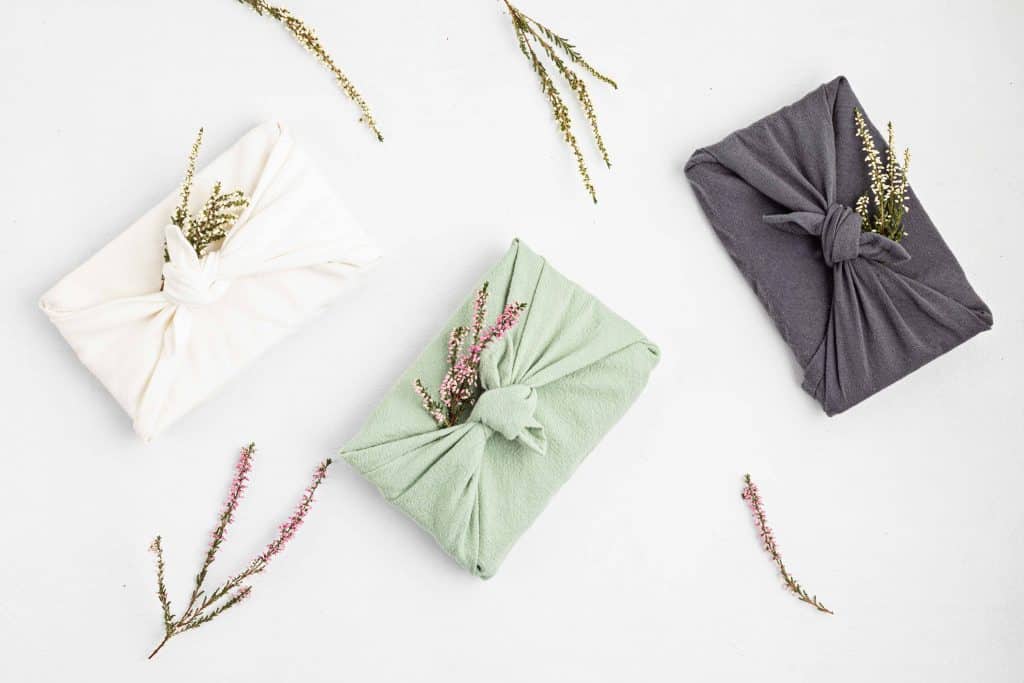
Credit: 123RF.com
11. The art of Furoshiki
The Japanese art of gift wrapping with reusable cloths is called Furoshiki. Traditionally, people used square pieces of colorful fabric. But you can get creative and upcycle scrap fabrics you have around the house.
Simply tie knots on opposite ends to create an eye-catching gift.
Other creative ideas
12. Cigar soap bands
Cigar soap bands, or soap bands are an economical, customizable, and eco-friendly way to package your soap. These thin strips of paperboard fit around the middle of each soap bar, allowing customers to see and smell the soap.
Of course, this option isn’t for everyone, nor does it work for all types of soaps.
Look for soap bands made of recycled materials. Most soap bands are recyclable, biodegradable, and compostable (so long as they don’t contain a waxy or plastic finish).
13. Coffee filters
I love the concept of using what you already have, and most of us have a few paper coffee filters around the house. If you have unbleached coffee filters, even better!
Simply place your soap in a coffee filter and secure together with jute or string.
Coffee filters are biodegradable and unbleached varieties are compostable.
14. Naked soap bars
Hey, if Lush can sell “naked” soap bars, maybe it’s worth a try. After all, the most eco-friendly packaging is no packaging at all!
This method works if you’re selling at a farmers’ market, for example, so customers could see and smell the soap.
Just be careful of different scents mingling together.
Types of string
And of course, we’ll need something to keep your packaging together. While tape or stickers works, it’s not the most green option.
A few natural string options include:
- Natural twine (or hemp twine);
- Raffia which is lightweight and made of natural veggie fibers; and
- Sisal, a natural, sustainable, and strong fiber.
Related questions
What are some eco friendly liquid soap packaging ideas?
Most liquid soap comes in plastic bottles with a hand pump.
While you can recycle many soap containers, most hand pumps are not recyclable and end up in the trash.
Consider packaging your liquid soap in a recyclable container sans hand pump.
What are some eco friendly stickers and labels for soap and body product?
Not all stickers and labels are recyclable. Most recycling facilities can’t recycle stickers, unfortunately.
The safest bet is to use hang tags (made of recycled paper) paired together with a natural string.
Why does soap need special packaging?
Soap bars sometimes need special packaging to protect it from moisture and other contaminants. Sometimes packaging also helps to preserve any fragrance in the soap product. But many makers of homemade soap are veering away from traditional packaging in an effort to reduce waste. For example, many soap makers at farmers’ markets and artisan soap shops choose to display and sell “naked” bars of soap.
Some types of handmade soap, like cold processed bars, actually need plenty of air circulation during storage. Other bars made from melt and pour methods require sealing in airtight packages to prevent “sweating.”
New to making soap? 🧼❓
👉We have a fantastic overview on the whole soapmaking process here: read our Timeless Guide To Soapmaking.
If you would like to see our soapmaking posts organized by topic type, see our Soapmaking Collection.

References
- The National Wildife Federation, Environmental Paper Network, https://www.nwf.org/Global-Warming/Personal-Solutions/Reduce-Reuse-Recycle/~/media/PDFs/Global%20Warming/Personal%20Solutions/underrecycledfiberfactsheet2.ashx. Accessed November 2023.
- Healabel, Burlap, https://healabel.com/b-fabrics-materials-textiles/burlap. Accessed November 2023.
- Stanfield, Savanna (27 May 2021). “Is Muslin Eco Friendly? Facts You Should Know (+3 Alternatives),” Citizen Sustainable. Accessed November 2023.
- The Packaging Company, Waxed Bags vs Glassine Bags: What’s the Difference?, https://www.thepackagingcompany.com/knowledge-sharing/waxed-bags-vs-glassine-bags-whats-the-difference/. Accessed November 2023.

Author: Theresa Tesolin
Theresa is co-founder of RusticWise. She helps people unleash their inner DIY spirit by encouraging them to get dirty and make or grow something from scratch.

